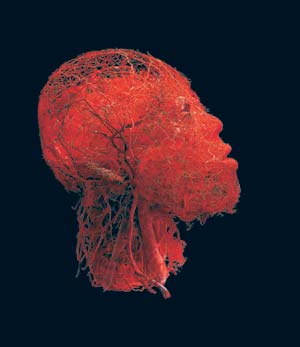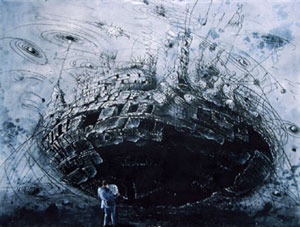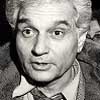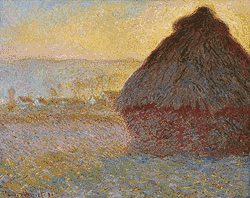Let me begin with a quotation:
What abstraction once tried to pull off is in fact being accomplished before our very eyes: the end of REPRESENTATIVE art and the substitution...of a PRESENTATIVE art.... (a) mise-en-abime of the body, of the figure... (in which) the intelligence of REPRESENTATION …gives way to the stunned mullet effect of a ‘presence’...that is not only weird but insulting to the mind…To demonstrate or to monstrate that is the question…Whether to practice some kind of aesthetic or ethic demonstration, or to practice the cleansing of all ‘nature’, or all ‘culture’ through the technically oriented efficiency of a mere monstration.”
This is from Paul Virilio’s recent Art and Fear, a text arguing that contemporary art, from painterly and sculptural abstraction to performance and trans-genetic art practice, is not only involved in, but responsible for, the actual destruction of forms and bodies. What the text suggests is an epistemological crisis, leading us to consider what is at stake in the face-off between ‘demonstration’ and ‘monstration’: what happens when, in Virilio’s words, re-presentation becomes presentation? It is from this point that I would like to begin a discussion of one of the exhibitions Virilio attacks: Professor Gunther von Hagens’s Bodyworlds (an exhibition that, though it has been on tour in Europe and Asia non-stop since 1996, has only just opened here in America-- it is currently on view in Los Angeles).
Through a preservation technique called ‘Plastination,’ Korperwelten translates images from Renaissance anatomical, and later art historical, texts (from Vesalius and Leonardo to Naum Gabo) into ‘real’ bodies through the use of donated corpses. (Briefly, plastination involves the removing of water and fat from cells which are replaced first by acetone, then silicon rubber or epoxy resin. After this, the body is cut, composed, cured with ultraviolet light and heat, and displayed.) Unprotected by ropes or glass, these self-standing sculptural objects, articulated into ‘life-like’ poses, remain accessible, available. One can scrutinize as closely as one might wish, and even the occasional touch is not forbidden. In line with conventional codes of anatomical display each piece has its own clearly specified didactic function. What is unorthodox, for the contemporary viewer at least, is the way these different functions are often articulated by alluding to works of art.
The Drawer Person, for example, is a rearticulation of Salvador Dali’s 1936 Anthropomorphic Cabinet; its stated aim: to show how neatly packed the various body structures really are. Another, now famous, plastinate, the Runner, has outer muscles that fly backward off of its bones, revealing different layers of muscle (both the outer and the lower muscles simultaneously) in a mimicry of Umberto Boccioni’s 1913 Unique Forms of Continuity in Space. And the Horseman, for his part, echoes the Horseman of the Apocalypse by Honore Fragonard, the 18th century professor of anatomy at the Ecole Nationale Vetrinaire D’Alfort in Paris. (Fragonard’s aim was to transform the body into a statue without translation into marble, plaster or bronze. To produce the Horseman he injected ‘Woods metal’, a metal alloy that melts at 70 degrees Celsius, into the specimen’s arteries. After the remaining tissue dried out, the entire preparation was treated with lacquer. In the plastinate version we are offered a man, body flayed and split twice to reveal underlying musculature, leading a plastinated horse over a jump.]
This short article comes out of a larger research project into death, representational practice and the body as material. In addressing Virilio’s reading of von Hagens for this article, however, the one question that frames my inquiry is the following: how can we understand von Hagens’s Bodyworlds in terms of ‘performance’? As a preliminary answer to this I suggest an interrogation of the logic of the radical particularity of the event.
Where anatomical models glide over considerable differences between people, the ‘authenticity’ of a Plastinate permits something to be learned beyond what any model can provide. In Bodyworlds, that something can be located in the affective charge of an encounter with the plastinated body as one’s posited material counterpart—an uncanny encounter with the particularity of one’s own dead body by proxy. As a viewer I know that this body is real, and a fantasy of equivalence is engaged: this is me, I am it, or: this could be me, I could be it. It is in this identification that the exhibition’s pedagogical promise fulfills itself.
My first visit to Korperwelten was at London’s Atlantis Gallery, Brick Lane, in 2002. As one entered the exhibition, it was made clear exactly how and why one might consider donating one’s body for plastination. (This was done through various means, including a large scale Xerox presenting handwritten testimony from one of the body donors.) Here are a few quotations taken from printed donation forms:
~‘‘I think about the idea that my human body will continue to teach. This is a kind of consolation.”
~“ For me it was about taking control of my death.”
~“I just like the idea of cross-sections of my body traveling around.It’s got to be more fun than being buried”
That is, not only is a strange materiality proposed, but a strange temporality. These statements project a particular kind of future, a phantasmatic attachment to the materiality of the body after death. In response to the call: You too can be forever and visibly productive in your death, you too can assure Purpose and Being into Later,comes the response: I will still be me, I will have Value, and, not only that,but I may even be having fun. According to von Hagens, “I am making the dead life-full again...(I offer) a death lived by anticipation, a death that crosses over into the sphere of life.” Beyond educational and aesthetic value, the experience of a death lived by anticipation is intended to have moral effect. Plastination art forces people to “think about themselves...(about) the unavoidable discussions as to whether it is ethically defensible to turn a human body into a work of art” (von Hagens).
To set the stage for at least the general direction that such an inquiry might take, I would like to tell you a story. Last December, after giving my first public talk on von Hagens’s work, one conference participant stood up saying that she simply could not let ‘this’ go by without protest. In face of imagery that she found disturbing, she found herself compelled to protest, not only against the practice that I was describing to her but the practice I was engaged in. ‘I am angry’ she said. ‘I am angry that you showed me this. I am angry that you think you have the right to show this imagery to a captive audience.’ She ended with the following: ‘Is it just that you are young that you can show this as if it were nothing? I feel sick. ’
Apart from a questionable insistence on captivity in a room that clearly had an unlocked door, and an assumption that censorship was the only legitimate reaction to von Hagens’s work, I am interested in the degree to which her reaction located us in the Virilian realm of the material vs. the demonstrative -- that is, between a conception of the abstract (theory/ that which ‘distances’) and a conception of the particular (event/ that from which there ‘can be no distance’). Virilio’s claim for this binary is that the “conformism of abjection” in the 20th century (figured in his text by everything from the Zurich Dadaists and the Futurist manifesto, to Stellarc, Eduardo Kac, and von Hagens) is involved, un-problematically and causally, in “paving the way for actual torturing of the viewer.” This, indeed, seems in line with my protester’s logic. For Virilio, the avant-garde artist (or theorist, or, in this case, anatomist) and the terrorist operate according to the same rules, and if the contemporary artist attacks symbols, it is violence as grave as attacking a passer-by.
Representational practices prefigure the next generation’s regulatory modes, and, thus, the abstractions of the turn-of-the-century German expressionists (Virilio’s favorite example), must be considered lethal. In turn, we are forced, Virilio claims (in the mode of linear causality), to acknowledge Mengele’s experiments as prefiguring Schwarzkogler, Herman Nitsch, and, of course, von Hagens. In his words (words that inversely echo von Hagens’s) contemporary art is “no more than a kind of exhibitionism that imposes its own terrorist voyeurism: that of death, live.”
Virilio’s narrative of decline moves us from an ideal of representation to an abstraction aligned with the direct, the unmediated and shatteringly monstrative – a ‘shatteringly monstrative’ that expresses itself in these performance art practices of the 70s and 80s as well as the turn to digital interventions and genetic engineering practices in the 90s. His narrative suggests a collapse between the representation and the represented that relies upon the very possibility of the unmediated event, of direct access. It relies upon the possibility of a relation that is always-already notphantasmatically mediated. A phantasmatic impossibility that I suggest we consider as equivalent to the previously mentioned fantasy of post-mortem fun: while psychologically strategic, it offers a theoretical problematic linked to an unmitigated desire for the ‘real’ and ‘transparent’— the “removal of all obstacles between the painter and the idea, the idea and the onlooker” (Virilio).
This conception of radical co-presence is what Virilio condemns. And unsurprisingly I join Virilio in his critical stance towards the projective fantasies of unmediated access. Where I depart is in his means of arrival, as well as the uses towards which he aims his critique. Virilio’s logic depends on the possibility of enforcing the ‘presentative’ and ‘representative’ as distinct and oppositional structures. It is on this opposition that his argument rests: the representative must remain on the side of the whole body, while the presentative is located unredeemably on the side of the shattered. My assertion, rather, is that the monstrative-presentative that Virilio so fears-- the shattering partiality that undoes the figural whole—can no more be seen as a ‘post’ to a ‘pre’ than a ‘pre’ to a ‘post.’ Instead, it might be more productive, as decades of psychoanalytic and post-structural literature would suggest, to consider the structures of the whole and shattered body as emerging in a particular complicity.
Let us turn to one moment of this complicity in psychoanalytic literature: that of the fetish. The narrative of fetishism’s inaugural encounter (the locus of representational practice par excellence) is one in which the imperative and possibility of a whole body only emerges in the face of the threat of its lack. In other words, the desired presence is entirely indebted to absence in order to be. ‘Affect’… ‘the sensual’…these terms articulate positions that seem on the side of a pure presence, but that only exist, as such, from within the symbolic frameworks that generate their legibility. In this turn to the structure of the fetish to articulate something about the rhetoric of pure presence, the presentative and representative emerge in a mutually constitutive dance. This dance, to draw on literary theorist Paul de Man, is a dance around the Material that follows the beat of a retroactive temporality.
I will begin my ending with a reference to this temporality that appears in a section of Paul de Man’s essay on “Kant’s Materiality”. It is one in which he invokes Jacques Derrida’s The Truth in Painting. De Man begins:
"But to quote Derrida: ‘When erection is at stake, one should never be in too much of a hurry -- one should let things take their course.’”
If we were to turn to that passage in Derrida from which de Man pulls his erection, however, we would see that it does not, indeed, begin with a capital letter, but in the middle of a sentence-- and the quotation that de Man offers us (his translation) appears in Derrida’s text only as a fragment, half of a parenthetical embedded in quite a substantial sentence. That sentence reads:
"The "almost-too-large" of the colossal (if we were in a hurry, we'd translate this as: of the phallus which doubles the corpse; but never be in a hurry when it's a matter of erection, let the thing happen) is thus determined, if one can still say so, in its relative indetermination, as almost too large with regard, if one could still say so, to the grasp, to apprehension, to our power of apprehension.”
If one can say, if one couldsay...but that’s just it, one can’t say. For, as de Man repeatedly insists, when it comes to the radically material encounter, language is lost. That which is posited as the radically material simply cannot be articulated in itself. In the moment of positing it, as such, already we are not in its realm; that positing must always and necessarily remain a constitutive fiction.
De Manian turn aside, then, what is at stake? I will return to the structure of performance that I invoked at the beginning of this endeavor. What I would like to suggest is that, in Virilio’s text, we might notice an echo of the logic of the Austinian performative utterance-- but here, it is the image, not the word, that ‘does’ (see: J.L. Austin, How To Do Things With Words and J. Derrida, ”Signature Event Context”). For Virilio, the image enacts, ‘does’, what it shows. That said, what we must recognize is that the political promise of the performative has everything to do with the inherent instability of language, and a turn to an effect that retroactively constitutes its cause, rather than prescriptively constituting its future. Virilio’s structure not only lays blame, but in the laying of blame promises a way out: police representational practice. (I am reminded of an uproar that emerged in the late 90s around the work of South African artist, Candice Breitz. At the time she responded to it by saying: “If I believed that censoring the representations of violence could stop violence, I’d be the first to burn my Hustlers and Reservoir Dogs. But the most powerful domain of representation – the imagination—is not that easily destroyed.” See Brenda Atkinson, Grey Areas)
I began by suggesting that ‘performance’ was the lens through which we should read Virilio’s reading of Bodyworlds. I will end with this re-itteration: a performative utterance is one that enacts what it enunciates. Within this structure, however, there is nowhere to ‘look’ to assure oneself of the truth of the utterance; it is agreed upon, and acted upon as if it were so. Like Bentham’s theory of fictions or a Foucaultian discourse analysis, it offers us a social network within which Truth is always historically and culturally produced, negotiated, intransitive.
Within this network it is impossible for representations to be self-evidently infused with the intentions of their makers, as tempting and comfortable as it might be for it to be so. For, if it were, we would always know what to do, and who to blame, in difficult times.
All images courtesy of the Institute for Plastination.
Natalie Loveless is a regular contributor to Big, Red & Shiny.




